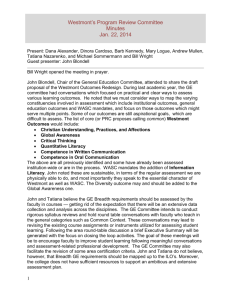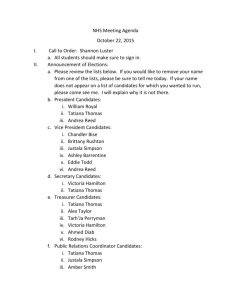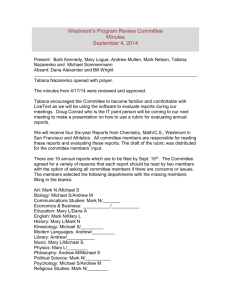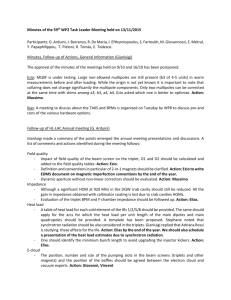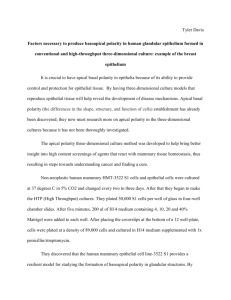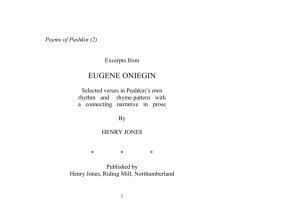Minutes_20150410_GA - Indico
advertisement
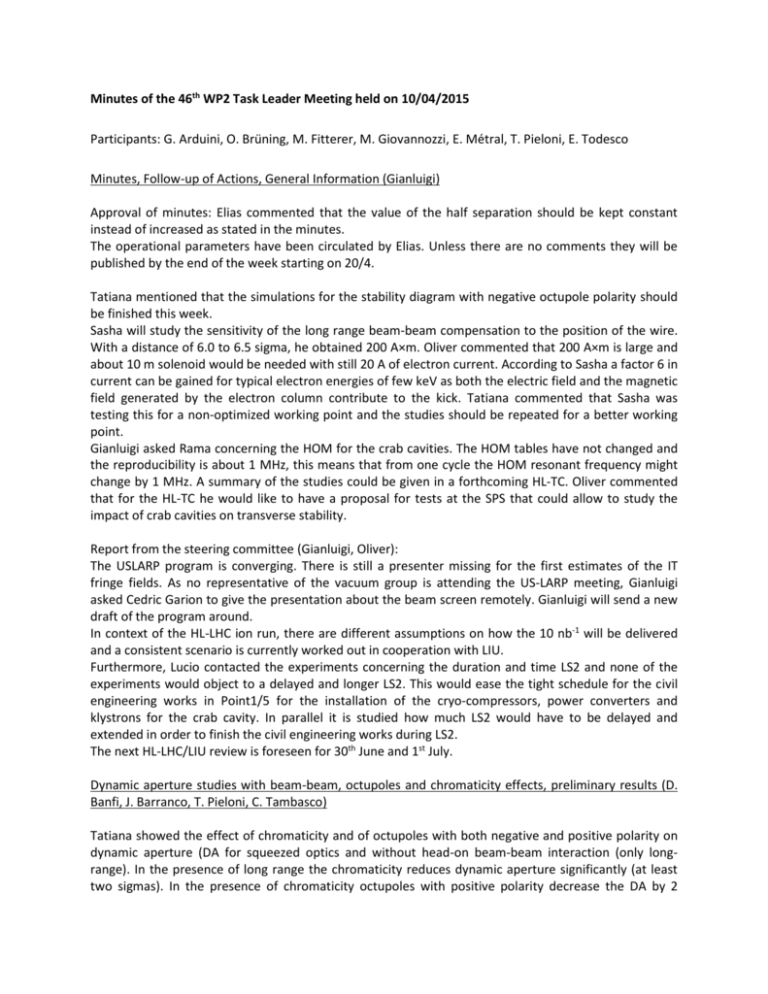
Minutes of the 46th WP2 Task Leader Meeting held on 10/04/2015 Participants: G. Arduini, O. Brüning, M. Fitterer, M. Giovannozzi, E. Métral, T. Pieloni, E. Todesco Minutes, Follow-up of Actions, General Information (Gianluigi) Approval of minutes: Elias commented that the value of the half separation should be kept constant instead of increased as stated in the minutes. The operational parameters have been circulated by Elias. Unless there are no comments they will be published by the end of the week starting on 20/4. Tatiana mentioned that the simulations for the stability diagram with negative octupole polarity should be finished this week. Sasha will study the sensitivity of the long range beam-beam compensation to the position of the wire. With a distance of 6.0 to 6.5 sigma, he obtained 200 A×m. Oliver commented that 200 A×m is large and about 10 m solenoid would be needed with still 20 A of electron current. According to Sasha a factor 6 in current can be gained for typical electron energies of few keV as both the electric field and the magnetic field generated by the electron column contribute to the kick. Tatiana commented that Sasha was testing this for a non-optimized working point and the studies should be repeated for a better working point. Gianluigi asked Rama concerning the HOM for the crab cavities. The HOM tables have not changed and the reproducibility is about 1 MHz, this means that from one cycle the HOM resonant frequency might change by 1 MHz. A summary of the studies could be given in a forthcoming HL-TC. Oliver commented that for the HL-TC he would like to have a proposal for tests at the SPS that could allow to study the impact of crab cavities on transverse stability. Report from the steering committee (Gianluigi, Oliver): The USLARP program is converging. There is still a presenter missing for the first estimates of the IT fringe fields. As no representative of the vacuum group is attending the US-LARP meeting, Gianluigi asked Cedric Garion to give the presentation about the beam screen remotely. Gianluigi will send a new draft of the program around. In context of the HL-LHC ion run, there are different assumptions on how the 10 nb-1 will be delivered and a consistent scenario is currently worked out in cooperation with LIU. Furthermore, Lucio contacted the experiments concerning the duration and time LS2 and none of the experiments would object to a delayed and longer LS2. This would ease the tight schedule for the civil engineering works in Point1/5 for the installation of the cryo-compressors, power converters and klystrons for the crab cavity. In parallel it is studied how much LS2 would have to be delayed and extended in order to finish the civil engineering works during LS2. The next HL-LHC/LIU review is foreseen for 30th June and 1st July. Dynamic aperture studies with beam-beam, octupoles and chromaticity effects, preliminary results (D. Banfi, J. Barranco, T. Pieloni, C. Tambasco) Tatiana showed the effect of chromaticity and of octupoles with both negative and positive polarity on dynamic aperture (DA for squeezed optics and without head-on beam-beam interaction (only longrange). In the presence of long range the chromaticity reduces dynamic aperture significantly (at least two sigmas). In the presence of chromaticity octupoles with positive polarity decrease the DA by 2 additional sigmas, while for the negative polarity the DA increases by approximately 2 sigmas. Also in terms of stability diagrams the negative octupole polarity would be preferable. In case of the negative polarity the octupoles do not compensate the effect of the long-range beam-beam interactions as similar results are obtained for Nb=1.1x1011 protons compared to Nb=2.2x1011 proton, in which case the effect of the long-range beam-beam encounters should be increased by a factor 2. The difference between the two polarities is due to the excitation of different resonances. In terms of detuning with the amplitude, the detuning with amplitude is positive in case of positive octupole polarity and negative in case of negative polarity, which is illustrated on the basis of the tune footprints up to 6 sigma. Oliver commented that the working point could be re-optimized in order to avoid the most dangerous resonances and he was wondering whether one could try if by mirroring the working point at the diagonal the results are inversed. Tatiana has already run simulations for different working points along the diagonal. Action Tatiana: send the DA results for the already performed tune scans along the diagonal (also for the LHC), study the sensitivity of the DA simulations to the WP and in particular the case of mirroring the WP on the diagonal. The DA simulations including head-on beam-beam interactions show the same sensitivity to chromaticity and to the octupole polarity. In case of the LHC with the 2015 parameters there is no significant difference in the dynamic aperture for the two polarities. This behavior in comparison to the HL-LHC is still to be understood and further studied. In case of the LHC the effect of the long-range beam-beam and octupoles is comparable, while for the HL-LHC the effect of the octupoles dominates. Massimo raises the question how this compares to the 2012 case. Action Tatiana: add 2012 case to DA plot. Tatiana gives an update on the DA simulations with the crossing angle in IP8 changed from 280 murad to 250 murad. The effect on the DA is small. Action Tatiana: document information of DA simulations in a note. Miscellaneous: Gianluigi mentioned that at the moment the known non-conformities are assumed to be removed after LS2 this topic could be addressed and summarized at the LMC in order to progress in this regard. Report from Task Leaders: Task 2.2 (Massimo): the simulations of the DA as a function of beta* are ongoing as well as the ones for the case with octupoles and different chromaticities (Yuri). The contribution of US-LARP on beam dynamics studies might be cut. Task 2.4 (Elias): Elias discussed with Ezio concerning the heat-load studies due to eddy currents and Luca confirmed that the heat load in case of eddy current effects should be small. Elias and Gianluigi asked to get an estimate for the heat-load due to eddy currents and thus prove that it is negligible. Action Ezio: provide estimate for heat-load due to eddy currents. Nicolo updated the impedance calculations for the scenario with amorphous carbon. Task 2.5 (Tatiana): M. Crouch and J. Jang will soon visit CERN for about 2 months. Yuri Alexahin will come for 2 months from September on. Tatiana will contact Alexahin to finalize the arrangements for his stay at CERN. Reported by Gianluigi and Miriam

